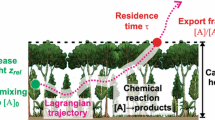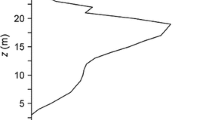Abstract
Proper understanding of, e.g., evaporation from a forest requires an understanding of its microclimate. A well established, steady-state model was used to simulate microclimate and evaporation of a sparse pine forest in central Sweden. Model input included profiles of turbulent diffusivity, boundary-layer resistance, stomatal resistance, wind speed, net and global radiation and needle area density. Momentum balance, energy balance and exponentially decreasing diffusivities were used to study the sensitivity of the evaporation rates and of the temperature and humidity profiles. Model output proved to be unreliable when measured temperature and humidity at the bottom of the stand were used instead of a measured ground heat flux as the lower boundary condition. Energy balance diffusivity was usually larger than momentum balance diffusivity at the canopy top but decreased rapidly to a minimum at approximately the height where the momentum balance diffusivity had its maximum. Energy balance diffusivity commonly showed a secondary maximum below the height of the maximum needle area density. Profiles of Richardson number showed that thermal effects became important just below the canopy top. Bluff-body effects distinguished the energy balance from the momentum balance diffusivity and both were subject to shelter effects. Total evaporation was not very sensitive to the choice of diffusivity when soil heat flux was given as the lower boundary condition.
Similar content being viewed by others
References
Axelsson, B. and Br»kenhielm, S.: 1980, ‘Investigation Sites of the Swedish Coniferous Forest Project-Biological and Physiographical Features’, in T. Persson (ed.), Structure and Function of Northern Coniferous Forests-An Ecosystem Study. Ecol Bull. 32, 25–64.
Chen, J.: 1984, ‘Uncoupled Multi-layer Model for the Transfer of Sensible and Latent Heat Flux Densities from Vegetation’, Boundary-Layer Meteorol. 28, 213–225.
Engelbrecht, B. and Svensson, J.: 1978, Data Collection, Storage, Retrieval and Analysis of Continuous Measurements, Technical Report 17, Swed. Con. For. Proj., Swed. Univ. Agric. Sci., Uppsala, Sweden. 47 pp.
Flower-Ellis, J. G. K. and Persson, H.: 1980, ‘Investigation of Structural Properties and Dynamics of Scots Pine Stands’, in T. Persson (ed.), Structure and Function of Northern Coniferous Forests-An Ecosystem Study. Ecol. Bull. 32, 125–138.
Furnival, G. M., Waggoner, P. E., and Reifsnyder, W. E.: 1975, ‘Computing the Energy Budget of a Leaf Canopy with Matrix Algebra and Numerical Integration’, Agric. Meteorol. 14, 405–416.
Goudriaan, J.: 1977, Crop Micrometeorology: a Simulation Study, Pudoc, Wageningen.
Goudriaan, J.: 1979, ‘MICROWEATHER Simulation Model, Applied to a Forest’, in S. Halldin (ed.), Comparison of Forest Water and Energy Exchange Models, International Society for Ecological Modelling, Copenhagen, pp. 47–57.
Goudriaan, J. and Waggoner, P. E.: 1972, ‘Simulating Both Aerial Microclimate and Soil Temperature from Observations above the Foliar Canopy’, Neth. J. Agric. Sci. 20, 104–124.
Halldin, S.: 1985, ‘Leaf and Bark Area Distribution in a Pine Forest’, in B. A. Hutchison and B. B. Hicks (eds.), The Forest-Atmosphere Interaction, D. Reidel Publ. Co., Dordrecht, Holland, pp. 39–58.
Inoue, E.: 1963, ‘On the Turbulent Structure of Airflow Within Crop Canopies’, J. Meteorol. Soc. Japan 41, 317–325.
Landsberg, J. J. and Jarvis, P. G.: 1973, ‘A Numerical Investigation of the Momentum Balance of a Spruce Forest’, J. Appl. Ecol. 10 2, 645–655.
Legg, B. and Monteith, J. L.: 1975, ‘Heat and Mass Transfer within Plant Canopies’, in D. A. de Vries and N. H. Afgan (eds.), Heat and Mass Transfer in the Biosphere, Part 1: Transfer Processes in the Plant Environment, Scripta Book Company, Washington, pp. 167–186.
Legg, B. J. and Long, I. F.: 1975, ‘Turbulent Diffusion Within a Wheat Canopy: II. Results and Interpretation’, Quart. J. Roy. Meteorol. Soc. 101, 611–628.
Lindgren, ». and Perttu, K.: 1979, ‘Climatic Data and Data Bases at Jädra»s Ecological Research Station’, in S. Halldin (ed.), Comparison of Forest Water and Energy Exchange Models, International Society for Ecological Modelling, Copenhagen, pp. 3–13.
Lindroth, A.: 1984, ‘Gradient Distributions and Flux Profile Relations above a Rough Forest’, Quart. J. Roy. Meteorol. Soc. 110, 553–563.
Lindroth, A. and Norén, B.: 1979, ‘Evapotranspiration Measurements at Jädra»s. Instrumentation, Data Gathering and Processing’, in S. Halldin (ed.) Comparison of Forest Water and Energy Exchange Models, International Society for Ecological Modelling, Copenhagen, pp. 15–26.
Lohammar, T., Larsson, S., Linder, S. and Falk, S. O.: 1980, ‘FAST-Simulation Models of Gaseous Exchange in Scots Pine’, in T. Persson (ed.), Structure and Function of Northern Coniferous Forests-An Ecosystem Study. Ecol. Bull. 32, 505–523.
Monteith, J. L.: 1973, Principles of Environmental Physics. Edward Arnold (Publishers) Limited, London. 241 pp.
Murphy, C. E. and Knoerr, K. R.: 1970, ‘A General Model for the Energy Exchange and Microclimate of Plant Communities’, Proceedings, Summer Computer Simulation Conference, Denver, Colorado, pp. 786–797.
Perrier, A.: 1976, Etude et essai de modélisation des échanges de masse et d'énergie au niveau des couverts végétaux. Thèse de Doctorat d'Etat, Université de Paris VI-avril 1976, Paris. 240 pp.
Perrier, A.: 1979, ‘Physical Model to Simulate Energy Exchange of Plant Canopies’, in S. Halldin (ed.), Comparison of Forest Water and Energy Exchange Models, International Society for Ecological Modelling, Copenhagen, pp. 101–113.
Perrier, A., Halldin, S. and Garthe, H.-J.: 1979, ‘Comparison of Energy Exchange Models’, in S. Halldin (ed.), Comparison of Forest Water and Energy Exchange Models, International Society for Ecological Modelling, Copenhagen, pp. 201–212.
Priestley, C. H. B.: 1959, Turbulent Transfer in the Lower Atmosphere, The University of Chicago Press, Chicago & London. 130 pp.
Raupach, M. R. and Thom, A. S.: 1981, ‘Turbulence in and Above Plant Canopies’, Ann. Rev. Fluid Mech. 13, 97–129.
Raupach, M. R. and Shaw, R. S.: 1982, ‘Averaging Procedures for Flow within Vegetation Canopies’, Boundary-Layer Meteorol. 22, 79–90.
Ripley, E. A. and Redmann, R. E.: 1976, ‘Grassland’, in J. L. Monteith (ed.), Vegetation and the Atmosphere. Vol. 2. Academic Press, London, pp. 349–398.
Shaw, R. S.: 1977, ‘Secondary Wind Speed Maxima Inside Plant Canopies’, J. Appl. Meteorol. 16, 514–521.
Shuttleworth, W. J.: 1976, ‘A One-Dimensional Theoretical Description of the Vegetation-Atmosphere Interaction’, Boundary-Layer Meteorol. 10, 273–302.
Thom, A. S.: 1971, ‘Momentum Absorption by Vegetation’, Quart. J. Roy. Meteorol. Soc. 97, 414–428.
Waggoner, P. E.: 1975, ‘Micrometeorological Models’, in J. L. Monteith (ed.), Vegetation and Atmosphere, Vol. I. Academic Press, London, pp. 205–228.
Waggoner, P. and Reifsnyder, W. E.: 1968, ‘Simulation of Temperature, Humidity and Evaporation Profiles in a Leaf Canopy’, J. Appl. Meteorol. 7, 400–409.
Waggoner, P. E., Furnival, G. M. and Reifsnyder, W. E.: 1969, ‘Simulation of the Microclimate in a Forest’, Forest Science 15, 37–45.
Waggoner, P. E. and Turner, N. C.: ‘Comparison of Simulated and Actual Evaporation from Maize and Soil in a Lysimeter’, Agric. Meteorol. 10, 113–123.
Wilson, N. R. and Shaw, R. S.: 1977, ‘A Higher Order Closure Model for Canopy Flow’, J. Appl. Meteorol. 16, 1197–1205.
Wright, J. L. and Brown, K. W.: 1967, ‘Comparison of Momentum and Energy Balance Methods of Computing Vertical Transfer Within a Crop’, Agron. J. 59, 427–432.
Author information
Authors and Affiliations
Rights and permissions
About this article
Cite this article
Halldin, S., Lindroth, A. Pine forest microclimate simulation using different diffusivities. Boundary-Layer Meteorol 35, 103–123 (1986). https://doi.org/10.1007/BF00117304
Received:
Issue Date:
DOI: https://doi.org/10.1007/BF00117304




